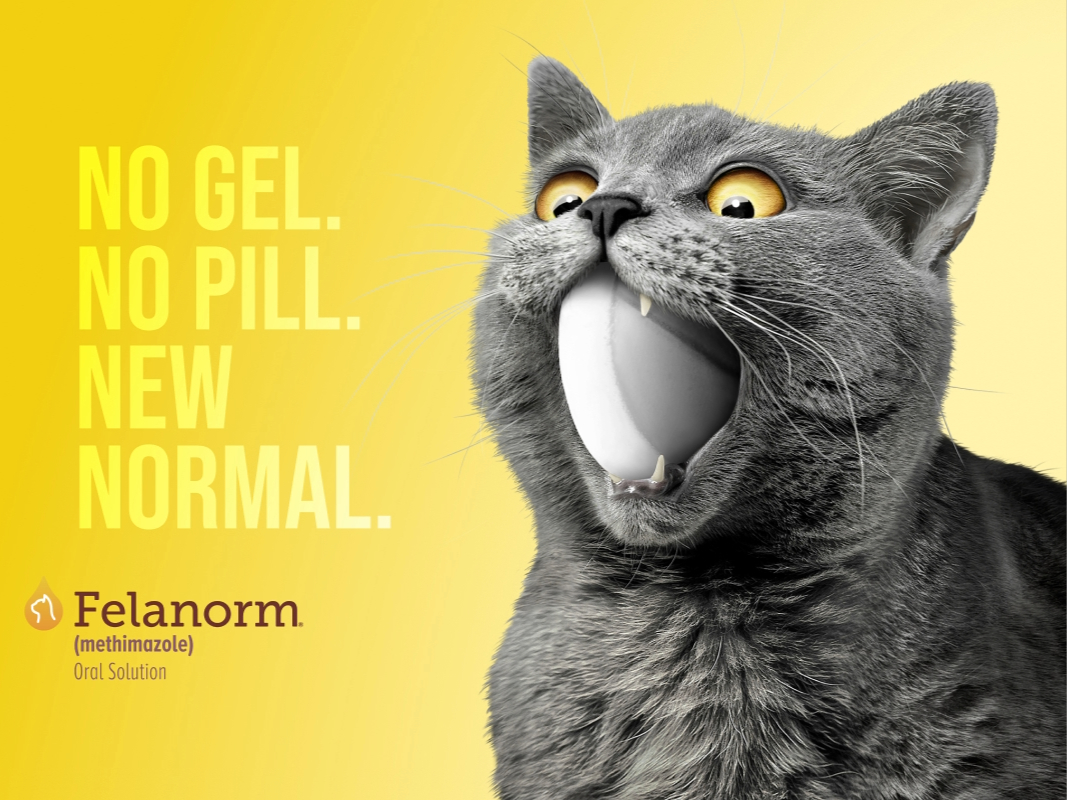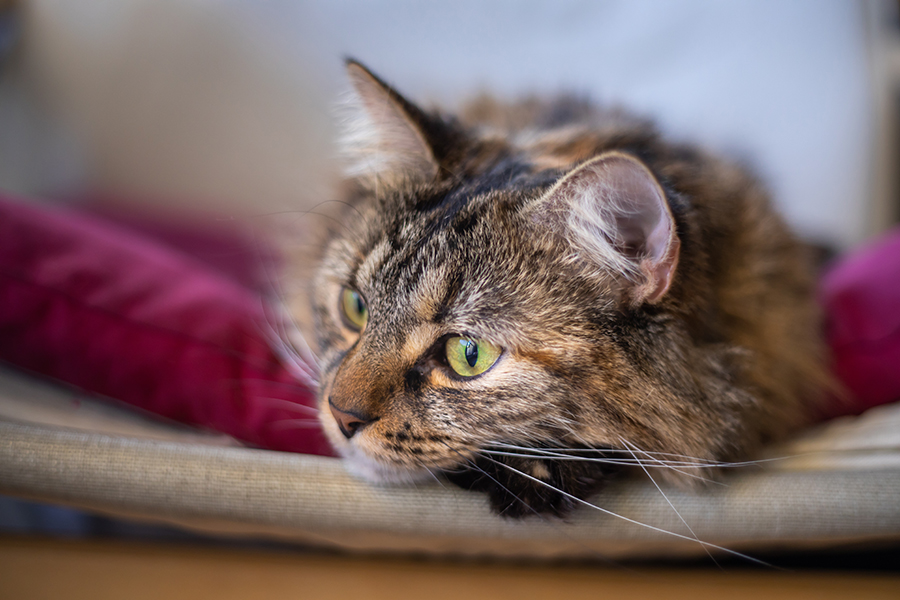Signs of Hyperthyroidism in Cats
Hearing that your cat has been diagnosed with hyperthyroidism can be a little overwhelming. What does that mean for your cat — will they be OK? Well, you’ll be happy to hear that if adequately treated and regularly monitored, most cats with hyperthyroidism can enjoy significantly improved quality of life and life expectancy. Good news for your kitty and you!
To help you learn more about feline hyperthyroidism, we’ve answered some common questions cat parents have about it. We’ll also discuss what the treatment options are, including an easy-to-administer, honey-flavored treatment for feline hyperthyroidism: Felanorm® (methimazole) Oral Solution.
What Is Feline Hyperthyroidism?
There are two thyroid glands in a cat’s neck that produce thyroid hormones to help regulate metabolism. Sometimes one thyroid gland (or both) develops a functional tumor (abnormal thyroid tissue) which overproduces thyroid hormones and causes hyperthyroidism. Hyperthyroidism is a common disease in cats, particularly older cats, and is thought to occur in about 10 percent of cats over 10 years of age.1,2
What Do Increased Thyroid Hormone Levels Do to Cats?
Hyperthyroidism can be problematic because thyroid hormones affect other organs in the cat’s body, most significantly the heart and kidneys. It can lead to increased cardiac output (the heart has to work harder) which causes high blood pressure and increased blood flow to the kidneys. It can also increase the absorption of glucose from the gut and increase fat metabolism.
Feline Hyperthyroidism Symptoms
The signs that your cat has hyperthyroidism may not be obvious to you in the beginning, but over time the symptoms can become increasingly worse. Most hyperthyroid cats lose weight even though they're often eating more and have increased appetites. Your cat may be drinking more water and urinating more — sometimes in inappropriate places like outside of the litter box. Their coat condition can change, meaning your usually well-groomed cat is looking a little raggedy and unkempt. You may also notice vomiting, diarrhea and restlessness or hyperactivity. Your cat may avoid warm places.
Symptoms of Hyperthyroidism in Cats
● Weight loss
● Increased appetite
● Increased drinking and urinating
● Poor haircoat quality (e.g., looks unkempt)
● Behavioral changes (e.g., hyperactivity, irritability, aggression or heat avoidance)
● Vomiting and/or diarrhea
Less obvious signs
● Hypertension (high blood pressure)
● Heart murmur or arrhythmia (irregular heartbeat)
● Decreased kidney function
● Enlarged thyroid glands
Why Is My Cat Losing Weight but Still Eating?
Weight loss is a common sign of hyperthyroidism, particularly when cats lose weight despite eating more food. Hyperthyroidism increases your cat’s metabolism, and if their body is burning more calories than they can consume, it can cause them to lose weight. There are other causes of weight loss and increased appetite, so you should consult your veterinarian if you notice these signs.
Why Is My Cat Drinking So Much Water?
The sped-up metabolism from hyperthyroidism can also cause your cat to become constantly thirsty. And not surprisingly, increased water intake can increase trips to the litter box. Again, there are other reasons cats can have increased water intake and increased urination (e.g., kidney disease, diabetes), so check with your veterinarian.
An Enlarged Thyroid Gland Could Mean Feline Hyperthyroidism
To diagnose hyperthyroidism, your veterinarian will begin by giving your cat a physical exam and checking their neck for an enlarged thyroid gland. If your veterinarian suspects that your cat has hyperthyroidism, they will likely conduct a few more tests, including a complete blood count, a urinalysis (urine test) and a blood chemistry panel that measures thyroid hormone (T4) levels and evaluates other organs.
Your veterinarian may also perform an ultrasound of your cat’s heart and measure their blood pressure. Once diagnosed, your cat will be closely monitored with regular checkups and blood work to make sure they’re healthy and responding well to treatment.
Treatment for Hyperthyroidism in Cats:
There are four options for treating hyperthyroid cats, each with its own pros and cons: radioactive iodine therapy, surgical treatment, dietary management and medical management.
● Radioactive Iodine Therapy
○ Could completely eliminate the disease
○ Has a high initial up-front cost
○ Requires a specialized facility
● Surgical Removal of the Thyroid Gland(s)
○ Could completely eliminate the disease
○ Has a high initial up-front cost
○ May require follow-up surgery
● Dietary Management
○ Requires a prescription diet for life
○ Will not eliminate the disease
○ Restricts your cat from eating most treats and other food
● Medical Management
○ Most common approach
○ Manageable cost that’s spread out over the life of your cat
○ Will not eliminate the disease
○ Requires daily medication
Methimazole Management of Hyperthyroidism in Cats
Medical management of feline hyperthyroidism in the U.S. is achieved with a drug called methimazole. Methimazole stabilizes and treats hyperthyroidism in cats and is available in multiple forms:
● An easy-to-give, honey-flavored oral solution (Felanorm® (methimazole) Oral Solution)
● Coated tablets (Felimazole® Coated Tablets (methimazole tablets))
● Human generic (non-coated) tablets
● Compounded oral formulations (liquid and chews)
● Compounded transdermals (absorbed through skin)
What Is Felanorm® (methimazole) Oral Solution for Cats?

Felanorm is the first FDA-approved oral solution for the treatment of cats diagnosed with hyperthyroidism. Felanorm is easy to use, easy to give and proven to help regulate the amount of thyroid hormones your cat produces. When used as directed by your veterinarian, it can effectively manage your cat’s condition and help them feel back to normal.
Felanorm® Benefits Cats and Their Humans
If you have ever tried to give your cat a pill, you know that “challenging” doesn’t begin to describe the process of getting your cat to swallow a pill. Few cats take oral tablets willingly, and it often ends with a resentful cat and a frustrated human.
Transdermal gels are generally easier to administer than pills, but they pose a potential health and safety risk to family members and other pets in the household due to exposure to the cat’s topical medication.
Felanorm can dramatically reduce the struggles associated with medicating cats.
Because Felanorm is a honey-flavored oral liquid that is easy to give to cats, it eliminates the struggle associated with trying to “pill” cats, as well as avoiding the potential health and safety risks associated with transdermal gels. It’s a methimazole formulation designed for cats that allows for flexible, accurate dosing with a syringe that is graduated to allow fine dose adjustments.
Felanorm®. Easy to Give. Easy to Trust.
- Awarded “Easy to Give” by the International Society of Feline Medicine.3
- Proven track record — over 100 million doses have been sold in the U.K.4
- Eliminate the mess and exposure risk of a gel
- No challenge in trying to give your cat a pill
- FDA-approved
- Two convenient sizes — 30 mL and an economical 100 mL

Ask Your Veterinarian About Felanorm® Today
If your veterinarian determines that Felanorm is appropriate for treating your cat’s hyperthyroidism, regular blood testing will be recommended to monitor your cat’s health and to evaluate response to treatment. If you have questions about your cat’s health or ongoing treatment, please speak with your veterinarian.
References
1 Carney HC, Ward CR, Bailey SJ, et al. 2016 AAFP Guidelines for the Management of Feline Hyperthyroidism. J Feline Med Surg 2016;18(5):400-416.
2 Peterson M. Hyperthyroidism in cats: what’s causing this epidemic of thyroid disease and can we prevent it? J Feline Med Surg 2012;14(11):804-818.
3 ISFM Easy-to-Give award 2017 (Note: Thyronorm® is the U.K. version of Felanorm; exact same formulation).
4 Kynetec Sales Data, U.K. (based on standard 2.5 mg dose).
IMPORTANT SAFETY INFORMATION
CAUTION: As with all drugs, side effects may occur. The most commonly reported side effects are anorexia, vomiting, head/facial pruritus or edema, depression/lethargy, weight loss, anemia, elevated liver enzymes, skin lesions, elevated BUN, diarrhea, and thrombocytopenia. Felanorm® Oral Solution is not for use in pregnant or lactating queens, or cats with renal, hepatic, or hematological disorders. In some reported cases, the patients recovered after adverse signs were recognized, the drug was withdrawn, and veterinary care was applied. In some cases, death (or euthanasia) has been reported as an outcome of the adverse reactions listed above.
Methimazole has anti‐vitamin K activity and may induce bleeding diathesis without evidence of thrombocytopenia. Refer to the prescribing information for complete details or visit www.norbrook.com.
US Patent Numbers: 10,045,967, US 11,123,327 and US 11,738,005
© 2024 Norbrook Laboratories Limited. The Norbrook logo and Felanorm are registered trademarks of Norbrook Laboratories Limited. 771-24-198









